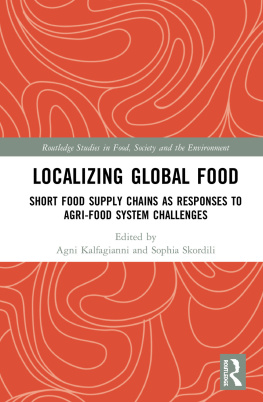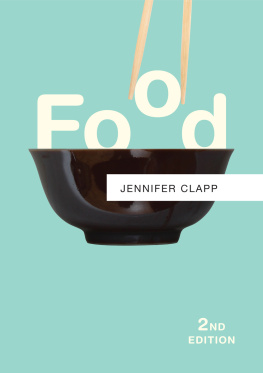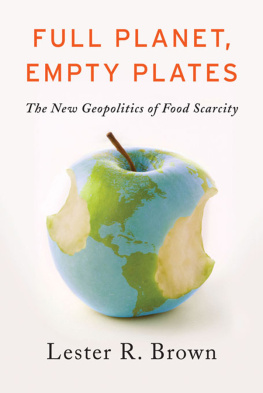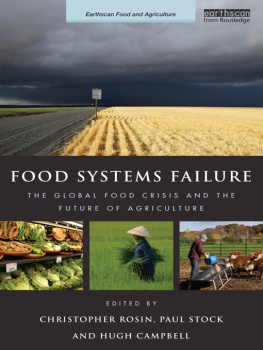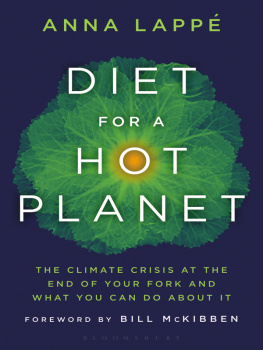FEEDING FRENZY
PAUL MCMAHON has authored reports on sustainable food systems as an advisor to The Prince of Waless International Sustainability Unit and to the UNs Food and Agriculture Organization. He co-founded and now helps run SLM Partners, a business that invests in sustainable agriculture in Australia and across the world. Born in Ireland, he holds a PhD from Cambridge University.
FEEDING FRENZY
The New Politics of Food
PAUL MCMAHON

First published in Great Britain in 2013 by
PROFILE BOOKS LTD
3A Exmouth House
Pine Street
London EC1R 0JH
www.profilebooks.com
Copyright Paul McMahon, 2013
1 3 5 7 9 10 8 6 4 2
Typeset in Bembo by MacGuru Ltd
info@macguru.org.uk
Printed and bound in Great Britain by
Clays, Bungay, Suffolk
The moral right of the author has been asserted.
All rights reserved. Without limiting the rights under copyright
reserved above, no part of this publication may be reproduced, stored
or introduced into a retrieval system, or transmitted, in any form or
by any means (electronic, mechanical, photocopying, recording or
otherwise), without the prior written permission of both the copyright
owner and the publisher of this book.
A CIP catalogue record for this book is available from the
British Library.
ISBN 978 1 78125 034 1
eISBN 978 1 84765 879 1
The paper this book is printed on is certified by the 1996 Forest
Stewardship Council A.C. (FSC). It is ancient-forest friendly. The
printer holds FSC chain of custody SGS-COC-2061

CONTENTS
The origins of agriculture, how it developed and the huge gaps that exist between farmers today.
Who feeds the world? A taxonomy of the global food system on the eve of crisis.
Richer diets, biofuels, wild weather and ecological limits the true causes of high food prices.
Population growth and carrying capacity a stock-take of the planets food resources.
Is this the end of cheap food? Structural shifts, price volatility and the new normal.
Export bans, panic purchases and why countries are stuck in a Prisoners Dilemma.
Are financial speculators to blame for higher food prices? Shadows and reality in futures markets.
The ABCD of commodity trading established companies, new competitors and the race to secure supply chains.
Foreign investment in farmland and the new scramble for Africa. Win-win or dangerous folly?
Dangerous trends, nightmare outcomes and the geopolitics of food in the twenty-first century.
Mapping out routes to a more sustainable and just food system.
INTRODUCTION
A gleaming steel fence is going up in a remote part of Africa. An alien construction, it dissects a landscape of open fields, mud huts and dirt tracks, where straight lines are elusive. On one side, diesel-powered tractors chew up the soil, containers packed with seed and fertiliser wait to be opened, and foreign managers look forward to a bumper harvest. On the other side, a local farmer in a tattered shirt scratches at the soil with a simple hoe, fearing that he may not be able to grow enough food for his family. Villagers cluster around the gate to the property, looking for work but muttering that the land rightly belongs to them. There are rumours that the young men are arming themselves so they can resist what they regard as a foreign land grab.
This story is playing out on the western fringes of Ethiopia, in a steamy region close to the border with South Sudan. The land has been acquired by a billionaire sheikh as part of an initiative launched by the Saudi government, which wants to grow more of its food abroad. Ethiopia, like most of Africa, may be better known for food scarcity and famine, rather than food abundance and exports, but this is one of dozens of similar projects to be launched across the continent since 2008.
The appearance of steel fences and satellite-guided tractors in one of the poorest parts of the world is a direct result of the turmoil that has gripped global food markets over the past five years. Food prices more than doubled between 2007 and 2008. Grain stocks fell to a dangerous level, and there were fears that supplies would not be available at any price. After a brief dip, prices rebounded in 2010 and jumped again in 2012. Food is a lot more expensive than a decade ago and does not look like getting any cheaper. We seem to be stuck in a never-ending food crisis.
Everyone can see the effect in their supermarket and restaurant bills. Higher food prices squeeze our incomes, meaning there is less to spend on everything else. But for the poor of the world the impacts are more dramatic. About one in eight people now go hungry each year. Millions of people have been forced deeper into poverty. High prices have sparked food riots and demonstrations in more than thirty countries. In January 2011 an iconic photograph emerged of a protester in Tunisia facing down riot police armed with nothing more than a baguette a symbol of how anger over food helped spark the Arab Spring.
Ferment in food markets has been seized upon by professional doom-mongers who believe the human race is living beyond its means. The Coming Famine, World on the Edge, Climate Change Peril, Peak Food, Peak Oil, even Peak Dirt these are some of the ideas and book titles that have circulated in recent years, all warning of an impending food collapse. Malthus, the nineteenth-century prophet of population catastrophe, is back in fashion. And another controversial idea is re-emerging after a long period of stigmatisation population control. Rich people in rich countries are once more telling poor people in poor countries to have fewer children.
There is no doubt that we are entering a challenging time. The human population will grow from 7 to 9 billion over the next forty years. Every year there are an extra 80 million mouths to feed. As the global middle class swells in size, people are demanding more expensive diets, which adds to the pressure on the planets resources. There is a question mark over the sustainability of modern agriculture because of its dependence on fossil fuels, the damage it inflicts on the environment and its vulnerability to a changing climate. Even the UK governments chief scientist, Professor Sir John Beddington, has warned that the food system is failing.
Can we feed a world of 9 billion by 2050? Is the current market turmoil an early sign that the global food system will not cope?
This book tries to answer these questions. It describes how the global food system works today, highlighting the huge inequalities and imbalances that pervade it. It reveals the real reasons behind the recent increase in food prices, exploring issues such as the role of biofuels, climate change, financial speculation and the rise of the Asian consumer. It looks at how demand for food is likely to develop over the next forty years and investigates whether food supplies will be able to keep up.
At the most basic level, this means assessing the biophysical potential of our planet the amount of land, water, energy and other natural resources that is available. It is a matter of hard science. But just because we can produce enough food does not mean that everyone will eat. Food security is determined not only by how much food is available but by whether people can access it and afford it. Therefore, the real answer will depend on the social, economic and political dimensions of the global food system. In particular the fate of millions of people will be determined by whether nations choose to compete or collaborate in a time of relative scarcity.





